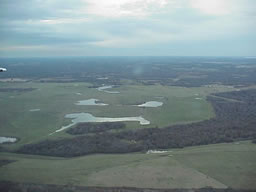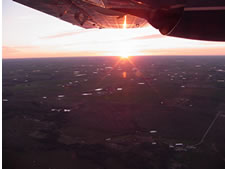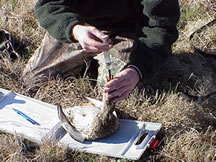Post Oak Savannah and Blackland Prairie Wildlife Management
Winter Feeding Habits and Condition of Female Mallards Utilizing Stock Ponds

Aerial Photo of stock ponds
Texas plays an important role for mallards (Anas platyrhynchos) wintering in the Central Flyway, and the Oak Woods/Blackland Prairie Region (OW/BPR) of Northeast Texas is one of the primary wintering areas for mallards in the state. Bottomland hardwood complexes in the OW/BPR have been drastically reduced due to drainage for flood control and clearing for agricultural development. Thus, remaining wetlands have become increasingly important to the perpetuation of waterfowl wintering in this region.
Traditional waterfowl biology suggests that, during the period from January through the completion of the northward migration, bottomland hardwoods play a critical role for mallards. Mallards utilize the sanctuaries and food resources available in forested wetlands to carry out biological functions such as molt, courtship, and nutrient acquisition to prepare for migration and subsequent reproduction.
Most information concerning the wintering ecology of mallards in southern regions pertains to bottomland hardwood habitats in the Mississippi Alluvial Valley and the Playa Lakes Region of the Southern High Plains. However, with the exception of greentree reservoirs, there is little information pertaining to the ecology of mallards wintering in man-made habitats. Yet, informed management decisions require an understanding of what foods are consumed in environments where man-made structures provide the primary habitat.

Stock Ponds
Stock ponds are becoming the most abundant wetland habitat in Northeast Texas. Stock ponds are small manmade water impoundments that serve as water supply for livestock and aid in soil conservation and flood control. In the OW/BPR stock pond densities are estimated to be as high as 7 ponds per square mile. TPW annual mid-winter waterfowl surveys indicate that an increasing number of mallards are utilizing stock ponds in this region during late winter.

Biologist collecting data from a female mallard
Approximately 35 female mallards will be collected from stock ponds, beginning January through the completion of the northward migration. Collections will take place over two winters. Paring status will be noted prior to collection, as well as waterfowl abundance on the stock ponds. Following collection, each bird will be aged and analyzed for foods consumed, body condition, and molt status.
This project should provide new information about the ecology and management of mallards in Northeast Texas. It will aid in our understanding of how stock ponds compare to forested wetlands as wintering mallard habitat. If this study indicates that mallards are being adequately served by stock ponds, then TPW and other conservation agencies should elevate the priority of these wetlands in conservation and management plans. Also, this project may provide the initial understanding of how to enhance and/or develop more of this habitat type.
Texas Parks and Wildlife is providing funding for this project with funds generated by the sale of state waterfowl stamps.
Links to other Waterfowl and Wetland Conservation pages can be found on the sidebar.
 (
(